A
lot of developers over the past few months have requested us for
tutorials focusing on LINQToXML. Although I have written a couple of
them in the past, I decided to republish these tips in the form of a
single post. In this article, we will explore 24 ‘How Do I’ kind of
examples using LINQ to XML. I assume you are familiar with LINQ. If not,
you can start off with LINQ by checking some tutorials over here and here.
Excel file API for: XLS, XLSX, CSV and ODS
For this article, we will be using a sample file called ‘Employees.xml’ for all our samples which is available with the source code. So make sure you keep it handy with you while are practicing these examples. The mark up for Employees.xml is as follows:
<?xml version="1.0" encoding="utf-8" ?>
<Employees>
<Employee>
<EmpId>1</EmpId>
<Name>Sam</Name>
<Sex>Male</Sex>
<Phone Type="Home">423-555-0124</Phone>
<Phone Type="Work">424-555-0545</Phone>
<Address>
<Street>7A Cox Street</Street>
<City>Acampo</City>
<State>CA</State>
<Zip>95220</Zip>
<Country>USA</Country>
</Address>
</Employee>
<Employee>
<EmpId>2</EmpId>
<Name>Lucy</Name>
<Sex>Female</Sex>
<Phone Type="Home">143-555-0763</Phone>
<Phone Type="Work">434-555-0567</Phone>
<Address>
<Street>Jess Bay</Street>
<City>Alta</City>
<State>CA</State>
<Zip>95701</Zip>
<Country>USA</Country>
</Address>
</Employee>
<Employee>
<EmpId>3</EmpId>
<Name>Kate</Name>
<Sex>Female</Sex>
<Phone Type="Home">166-555-0231</Phone>
<Phone Type="Work">233-555-0442</Phone>
<Address>
<Street>23 Boxen Street</Street>
<City>Milford</City>
<State>CA</State>
<Zip>96121</Zip>
<Country>USA</Country>
</Address>
</Employee>
<Employee>
<EmpId>4</EmpId>
<Name>Chris</Name>
<Sex>Male</Sex>
<Phone Type="Home">564-555-0122</Phone>
<Phone Type="Work">442-555-0154</Phone>
<Address>
<Street>124 Kutbay</Street>
<City>Montara</City>
<State>CA</State>
<Zip>94037</Zip>
<Country>USA</Country>
</Address>
</Employee>
</Employees>
The
application is a console application targeting .NET 3.5 framework,
although you can use the latest .NET 4.0 framework too. I have also used
‘query expressions’, instead of Lambda expression in these samples. It
is just a matter of preference and you are free to use any of these.
This tutorial has been divided into 2 sections:
Section 1: Read XML and Traverse the Document using LINQ To XML
Section 2: Manipulate XML content and Persist the changes using LINQ To XML
The
following namespaces are needed while testing the samples:
System; System.Collections.Generic; System.Linq; System.Text;
System.Xml; System.Xml.Linq;
Go grab a hot cup of coffee, put on your developer cap and let us get started:
Section 1: Read XML and Traverse the XML Document using LINQ To XML
1. How Do I Read XML using LINQ to XML
There
are two ways to do so: Using the XElement class or the XDocument class.
Both the classes contain the ‘Load()’ method which accepts a file, a
URL or XMLReader and allows XML to be loaded. The primary difference
between both the classes is that an XDocument can contain XML
declaration, XML Document Type (DTD) and processing instructions.
Moreover an XDocument contains one root XElement.
Using XElement
C#
XElement xelement = XElement.Load("..\\..\\Employees.xml");
IEnumerable<XElement> employees = xelement.Elements();
// Read the entire XML
foreach (var employee in employees)
{
Console.WriteLine(employee);
}
VB.NET (Converted Code)
Dim xelement As XElement = XElement.Load("..\..\Employees.xml")
Dim employees As IEnumerable(Of XElement) = xelement.Elements()
' Read the entire XML
For Each employee In employees
Console.WriteLine(employee)
Next employee
Output:

Using XDocument
C#
XDocument xdocument = XDocument.Load("..\\..\\Employees.xml");
IEnumerable<XElement> employees = xdocument.Elements();
foreach (var employee in employees)
{
Console.WriteLine(employee);
}
VB.NET (Converted Code)
Dim xdocument As XDocument = XDocument.Load("..\..\Employees.xml")
Dim employees As IEnumerable(Of XElement) = xdocument.Elements()
For Each employee In employees
Console.WriteLine(employee)
Next employee
Output:

Note 1: As you can observe, XDocument contains a single root element (Employees).
Note
2: In order to generate an output similar to the one using XElement,
use “xdocument.Root.Elements()” instead of “xdocument.Elements()”
Note 3: VB.NET users can use a new feature called XML Literal.
2. How Do I Access a Single Element using LINQ to XML
Let us see how to access the name of all the Employees and list them over here
C#
XElement xelement = XElement.Load("..\\..\\Employees.xml");
IEnumerable<XElement> employees = xelement.Elements();
Console.WriteLine("List of all Employee Names :");
foreach (var employee in employees)
{
Console.WriteLine(employee.Element("Name").Value);
}
VB.NET (Converted Code)
Dim xelement As XElement = XElement.Load("..\..\Employees.xml")
Dim employees As IEnumerable(Of XElement) = xelement.Elements()
Console.WriteLine("List of all Employee Names :")
For Each employee In employees
Console.WriteLine(employee.Element("Name").Value)
Next employee
Output:

3. How Do I Access Multiple Elements using LINQ to XML
Let us see how to access the name of all Employees and also list the ID along with it
C#
XElement xelement = XElement.Load("..\\..\\Employees.xml");
IEnumerable<XElement> employees = xelement.Elements();
Console.WriteLine("List of all Employee Names along with their ID:");
foreach (var employee in employees)
{
Console.WriteLine("{0} has Employee ID {1}",
employee.Element("Name").Value,
employee.Element("EmpId").Value);
}
VB.NET (Converted Code)
Dim xelement As XElement = XElement.Load("..\..\Employees.xml")
Dim employees As IEnumerable(Of XElement) = xelement.Elements()
Console.WriteLine("List of all Employee Names along with their ID:")
For Each employee In employees
Console.WriteLine("{0} has Employee ID {1}", employee.Element("Name").Value, employee.Element("EmpId").Value)
Next employee
Output:

4. How Do I Access all Elements having a Specific Attribute using LINQ to XML
Let us see how to access details of all Female Employees
C#
XElement xelement = XElement.Load("..\\..\\Employees.xml");
var name = from nm in xelement.Elements("Employee")
where (string)nm.Element("Sex") == "Female"
select nm;
Console.WriteLine("Details of Female Employees:");
foreach (XElement xEle in name)
Console.WriteLine(xEle);
VB.NET (Converted Code)
Dim xelement As XElement = XElement.Load("..\..\Employees.xml")
Dim name = _
From nm In xelement.Elements("Employee") _
Where CStr(nm.Element("Sex")) = "Female" _
Select nm
Console.WriteLine("Details of Female Employees:")
For Each xEle As XElement In name
Console.WriteLine(xEle)
Next xEle
Output:

5. How Do I access Specific Element having a Specific Attribute using LINQ to XML
Let us see how to list all the Home Phone Nos.
C#
XElement xelement = XElement.Load("..\\..\\Employees.xml");
var homePhone = from phoneno in xelement.Elements("Employee")
where (string)phoneno.Element("Phone").Attribute("Type") == "Home"
select phoneno;
Console.WriteLine("List HomePhone Nos.");
foreach (XElement xEle in homePhone)
{
Console.WriteLine(xEle.Element("Phone").Value);
}
VB.NET (Converted Code)
Dim xelement As XElement = XElement.Load("..\..\Employees.xml")
Dim homePhone = _
From phoneno In xelement.Elements("Employee") _
Where CStr(phoneno.Element("Phone").Attribute("Type")) = "Home" _
Select phoneno
Console.WriteLine("List HomePhone Nos.")
For Each xEle As XElement In homePhone
Console.WriteLine(xEle.Element("Phone").Value)
Next xEle
Output:

6. How Do I Find an Element within another Element using LINQ to XML
Let us see how to find the details of Employees living in 'Alta' City
C#
XElement xelement = XElement.Load("..\\..\\Employees.xml");
var addresses = from address in xelement.Elements("Employee")
where (string)address.Element("Address").Element("City") == "Alta"
select address;
Console.WriteLine("Details of Employees living in Alta City");
foreach (XElement xEle in addresses)
Console.WriteLine(xEle);
VB.NET (Converted Code)
Dim xelement As XElement = XElement.Load("..\..\Employees.xml")
Dim addresses = _
From address In xelement.Elements("Employee") _
Where CStr(address.Element("Address").Element("City")) = "Alta" _
Select address
Console.WriteLine("Details of Employees living in Alta City")
For Each xEle As XElement In addresses
Console.WriteLine(xEle)
Next xEle
Output:

7. How Do I Find Nested Elements (using Descendants Axis) using LINQ to XML
Let us see how to list all the zip codes in the XML file
C#
XElement xelement = XElement.Load("..\\..\\Employees.xml");
Console.WriteLine("List of all Zip Codes");
foreach (XElement xEle in xelement.Descendants("Zip"))
{
Console.WriteLine((string)xEle);
}
VB.NET (Converted Code)
Dim xelement As XElement = XElement.Load("..\..\Employees.xml")
Console.WriteLine("List of all Zip Codes")
For Each xEle As XElement In xelement.Descendants("Zip")
Console.WriteLine(CStr(xEle))
Next xEle
Output:

8. How do I apply Sorting on Elements using LINQ to XML
Let us see how to List and Sort all Zip Codes in ascending order
C#
XElement xelement = XElement.Load("..\\..\\Employees.xml");
IEnumerable<string> codes = from code in xelement.Elements("Employee")
let zip = (string)code.Element("Address").Element("Zip")
orderby zip
select zip;
Console.WriteLine("List and Sort all Zip Codes");
foreach (string zp in codes)
Console.WriteLine(zp);
VB.NET (Converted Code)
Dim xelement As XElement = XElement.Load("..\..\Employees.xml")
Dim codes As IEnumerable(Of String) = _
From code In xelement.Elements("Employee") _
Let zip = CStr(code.Element("Address").Element("Zip")) _
Order By zip _
Select zip
Console.WriteLine("List and Sort all Zip Codes")
For Each zp As String In codes
Console.WriteLine(zp)
Next zp
Output:

Section 2: Manipulate XML content and Persist the changes using LINQ To XML
9. Create an XML Document with Xml Declaration/Namespace/Comments using LINQ to XML
When
you need to create an XML document containing XML declaration, XML
Document Type (DTD) and processing instructions, Comments, Namespaces,
you should go in for the XDocument class.
C#
XNamespace empNM = "urn:lst-emp:emp";
XDocument xDoc = new XDocument(
new XDeclaration("1.0", "UTF-16", null),
new XElement(empNM + "Employees",
new XElement("Employee",
new XComment("Only 3 elements for demo purposes"),
new XElement("EmpId", "5"),
new XElement("Name", "Kimmy"),
new XElement("Sex", "Female")
)));
StringWriter sw = new StringWriter();
xDoc.Save(sw);
Console.WriteLine(sw);
VB.NET (Converted Code)
Dim empNM As XNamespace = "urn:lst-emp:emp"
Dim xDoc As New XDocument(New XDeclaration("1.0", "UTF-16", Nothing), _
New XElement(empNM + "Employees", _
New XElement("Employee", _
New XComment("Only 3 elements for demo purposes"), _
New XElement("EmpId", "5"), _
New XElement("Name", "Kimmy"), _
New XElement("Sex", "Female"))))
Dim sw As New StringWriter()
xDoc.Save(sw)
Console.WriteLine(sw)

10. Save the XML Document to a XMLWriter or to the disk using LINQ to XML
Use the following code to save the XML to a XMLWriter or to your physical disk
C#
XNamespace empNM = "urn:lst-emp:emp";
XDocument xDoc = new XDocument(
new XDeclaration("1.0", "UTF-16", null),
new XElement(empNM + "Employees",
new XElement("Employee",
new XComment("Only 3 elements for demo purposes"),
new XElement("EmpId", "5"),
new XElement("Name", "Kimmy"),
new XElement("Sex", "Female")
)));
StringWriter sw = new StringWriter();
XmlWriter xWrite = XmlWriter.Create(sw);
xDoc.Save(xWrite);
xWrite.Close();
// Save to Disk
xDoc.Save("C:\\Something.xml");
Console.WriteLine("Saved");
VB.NET (Converted Code)
Dim empNM As XNamespace = "urn:lst-emp:emp"
Dim xDoc As New XDocument(New XDeclaration("1.0", "UTF-16", Nothing),_
New XElement(empNM + "Employees", _
New XElement("Employee", _
New XComment("Only 3 elements for demo purposes"), _
New XElement("EmpId", "5"), _
New XElement("Name", "Kimmy"), _
New XElement("Sex", "Female"))))
Dim sw As New StringWriter()
Dim xWrite As XmlWriter = XmlWriter.Create(sw)
xDoc.Save(xWrite)
xWrite.Close()
' Save to Disk
xDoc.Save("C:\Something.xml")
Console.WriteLine("Saved")
11. Load an XML Document using XML Reader using LINQ to XML
Use the following code to load the XML Document into an XML Reader
C#
XmlReader xRead = XmlReader.Create(@"..\\..\\Employees.xml");
XElement xEle = XElement.Load(xRead);
Console.WriteLine(xEle);
xRead.Close();
VB.NET (Converted Code)
Dim xRead As XmlReader = XmlReader.Create("..\\..\\Employees.xml")
Dim xEle As XElement = XElement.Load(xRead)
Console.WriteLine(xEle)
xRead.Close()
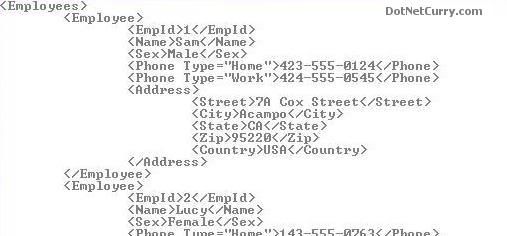
12. Find Element at a Specific Position using LINQ to XML
Find the 2nd Employee Element
C#
// Using XElement
Console.WriteLine("Using XElement");
XElement xEle = XElement.Load("..\\..\\Employees.xml");
var emp1 = xEle.Descendants("Employee").ElementAt(1);
Console.WriteLine(emp);
Console.WriteLine("------------");
//// Using XDocument
Console.WriteLine("Using XDocument");
XDocument xDoc = XDocument.Load("..\\..\\Employees.xml");
var emp1 = xDoc.Descendants("Employee").ElementAt(1);
Console.WriteLine(emp);
VB.NET (Converted Code)
' Using XElement
Console.WriteLine("Using XElement")
Dim xEle As XElement = XElement.Load("..\..\Employees.xml")
Dim emp1 = xEle.Descendants("Employee").ElementAt(1)
Console.WriteLine(emp)
Console.WriteLine("------------")
'// Using XDocument
Console.WriteLine("Using XDocument")
Dim xDoc As XDocument = XDocument.Load("..\..\Employees.xml")
Dim emp1 = xDoc.Descendants("Employee").ElementAt(1)
Console.WriteLine(emp)
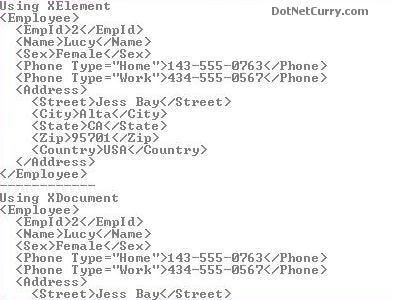
13. List the First 2 Elements using LINQ to XML
List the details of the first 2 Employees
C#
XElement xEle = XElement.Load("..\\..\\Employees.xml");
var emps = xEle.Descendants("Employee").Take(2);
foreach (var emp in emps)
Console.WriteLine(emp);
VB.NET (Converted Code)
Dim xEle As XElement = XElement.Load("..\..\Employees.xml")
Dim emps = xEle.Descendants("Employee").Take(2)
For Each emp In emps
Console.WriteLine(emp)
Next emp

14. List the 2nd and 3rd Element using LINQ to XML
List the 2nd and 3rd Employees
C#
XElement xEle = XElement.Load("..\\..\\Employees.xml");
var emps = xEle.Descendants("Employee").Skip(1).Take(2);
foreach (var emp in emps)
Console.WriteLine(emp);
VB.NET (Converted Code)
Dim xEle As XElement = XElement.Load("..\..\Employees.xml")
Dim emps = xEle.Descendants("Employee").Skip(1).Take(2)
For Each emp In emps
Console.WriteLine(emp)
Next emp
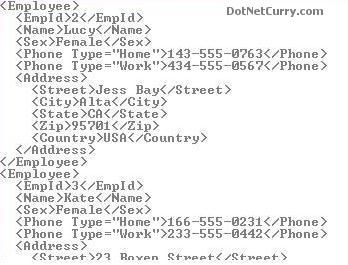
15. List the Last 2 Elements using LINQ To XML
We
have been posting the entire elements as output in our previous
examples. Let us say that you want to display only the Employee Name,
use this query:
C#
XElement xEle = XElement.Load("..\\..\\Employees.xml");
var emps = xEle.Descendants("Employee").Reverse().Take(2);
foreach (var emp in emps)
Console.WriteLine(emp.Element("EmpId") + "" + emp.Element("Name"));
VB.NET (Converted Code)
Dim xEle As XElement = XElement.Load("..\..\Employees.xml")
Dim emps = xEle.Descendants("Employee").Reverse().Take(2)
For Each emp In emps
Console.WriteLine(emp.Element("EmpId") + emp.Element("Name"))
Next emp

To display only the values without the XML tags, use the ‘Value’ property
C#
XElement xEle = XElement.Load("..\\..\\Employees.xml");
var emps = xEle.Descendants("Employee").Reverse().Take(2);
foreach (var emp in emps)
Console.WriteLine(emp.Element("EmpId").Value + ". " + emp.Element("Name").Value);
VB.NET (Converted Code)
Dim xEle As XElement = XElement.Load("..\..\Employees.xml")
Dim emps = xEle.Descendants("Employee").Reverse().Take(2)
For Each emp In emps
Console.WriteLine(emp.Element("EmpId").Value & ". " & emp.Element("Name").Value)
Next emp

If
you notice, the results are not ordered i.e. the Employee 4 is printed
before 3. To order the results, just add call Reverse() again while
filtering as shown below:
C#
XElement xEle = XElement.Load("..\\..\\Employees.xml");
var emps = xEle.Descendants("Employee").Reverse().Take(2).Reverse();
foreach (var emp in emps)
Console.WriteLine(emp.Element("EmpId").Value + ". " + emp.Element("Name").Value);
VB.NET (Converted Code)
Dim xEle As XElement = XElement.Load("..\..\Employees.xml")
Dim emps = xEle.Descendants("Employee").Reverse().Take(2).Reverse()
For Each emp In emps
Console.WriteLine(emp.Element("EmpId").Value & ". " & emp.Element("Name").Value)
Next emp

16. Find the Element Count based on a condition using LINQ to XML
Count the number of Employees living in the state CA
C#
XElement xelement = XElement.Load("..\\..\\Employees.xml");
var stCnt = from address in xelement.Elements("Employee")
where (string)address.Element("Address").Element("State") == "CA"
select address;
Console.WriteLine("No of Employees living in CA State are {0}", stCnt.Count());
VB.NET (Converted Code)
XElement xelement = XElement.Load("..\\..\\Employees.xml");
var stCnt = from address in xelement.Elements("Employee")
where (string)address.Element("Address").Element("State") == "CA"
select address;
Console.WriteLine("No of Employees living in CA State are {0}", stCnt.Count());

17. Add a new Element at runtime using LINQ to XML
You
can add a new Element to an XML document at runtime by using the Add()
method of XElement. The new Element gets added as the last element of
the XML document.
C#
XElement xEle = XElement.Load("..\\..\\Employees.xml");
xEle.Add(new XElement("Employee",
new XElement("EmpId", 5),
new XElement("Name", "George")));
Console.Write(xEle);
VB.NET (Converted Code)
Dim xEle As XElement = XElement.Load("..\..\Employees.xml")
xEle.Add(New XElement("Employee", _
New XElement("EmpId", 5), _
New XElement("Name", "George")))
Console.Write(xEle)
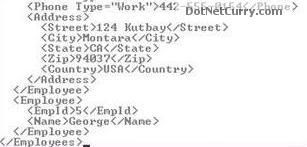
18. Add a new Element as the First Child using LINQ to XML
In
the previous example, by default the new Element gets added to the end
of the XML document. If you want to add the Element as the First Child,
use the ‘AddFirst()’ method
C#
XElement xEle = XElement.Load("..\\..\\Employees.xml");
xEle.AddFirst(new XElement("Employee",
new XElement("EmpId", 5),
new XElement("Name", "George")));
Console.Write(xEle);
VB.NET (Converted Code)
Dim xEle As XElement = XElement.Load("..\..\Employees.xml")
xEle.AddFirst(New XElement("Employee", _
New XElement("EmpId", 5), _
New XElement("Name", "George")))
Console.Write(xEle)
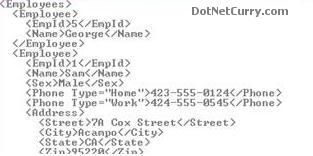
19. Add an attribute to an Element using LINQ to XML
To add an attribute to an Element, use the following code:
C#
XElement xEle = XElement.Load("..\\..\\Employees.xml");
xEle.Add(new XElement("Employee",
new XElement("EmpId", 5),
new XElement("Phone", "423-555-4224", new XAttribute("Type", "Home"))));
Console.Write(xEle);
VB.NET (Converted Code)
Dim xEle As XElement = XElement.Load("..\..\Employees.xml")
xEle.Add(New XElement("Employee", _
New XElement("EmpId", 5), _
New XElement("Phone", "423-555-4224", _
New XAttribute("Type", "Home"))))
Console.Write(xEle)
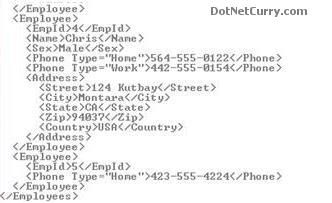
20. Replace Contents of an Element/Elements using LINQ to XML
Let
us say that in the XML file, you want to change the Country from “USA”
to “United States of America” for all the Elements. Here’s how to do so:
C#
XElement xEle = XElement.Load("..\\..\\Employees.xml");
var countries = xEle.Elements("Employee").Elements("Address").Elements("Country").ToList();
foreach (XElement cEle in countries)
cEle.ReplaceNodes("United States Of America");
Console.Write(xEle);
VB.NET (Converted Code)
Dim xEle As XElement = XElement.Load("..\..\Employees.xml")
Dim countries = xEle.Elements("Employee").Elements("Address").Elements("Country").ToList()
For Each cEle As XElement In countries
cEle.ReplaceNodes("United States Of America")
Next cEle
Console.Write(xEle)
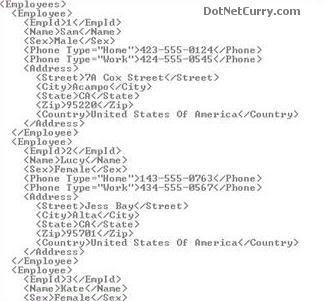
21. Remove an attribute from all the Elements using LINQ to XML
Let
us say if you want to remove the Type attribute ( <Phone
Type=”Home”>) attribute for all the elements, then here’s how to do
it.
C#
XElement xEle = XElement.Load("..\\..\\Employees.xml");
var phone = xEle.Elements("Employee").Elements("Phone").ToList();
foreach (XElement pEle in phone)
pEle.RemoveAttributes();
Console.Write(xEle);
VB.NET (Converted Code)
Dim xEle As XElement = XElement.Load("..\..\Employees.xml")
Dim phone = xEle.Elements("Employee").Elements("Phone").ToList()
For Each pEle As XElement In phone
pEle.RemoveAttributes()
Next pEle
Console.Write(xEle)
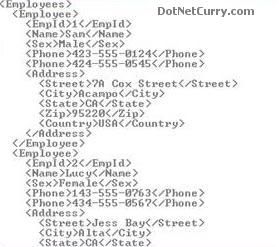
To
remove attribute of one Element based on a condition, traverse to that
Element and SetAttributeValue("Type", null); You can also use
SetAttributeValue(XName,object) to update an attribute value.
22. Delete an Element based on a condition using LINQ to XML
If you want to delete an entire element based on a condition, here’s how to do it. We are deleting the entire Address Element
C#
XElement xEle = XElement.Load("..\\..\\Employees.xml");
var addr = xEle.Elements("Employee").ToList();
foreach (XElement addEle in addr)
addEle.SetElementValue("Address", null);
Console.Write(xEle);
VB.NET (Converted Code)
Dim xEle As XElement = XElement.Load("..\..\Employees.xml")
Dim addr = xEle.Elements("Employee").ToList()
For Each addEle As XElement In addr
addEle.SetElementValue("Address", Nothing)
Next addEle
Console.Write(xEle)
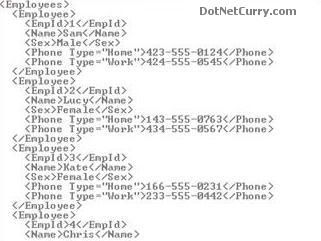
SetElementValue() can also be used to Update the content of an Element.
23. Remove ‘n’ number of Elements using LINQ to XML
If
you have a requirement where you have to remove ‘n’ number of Elements;
For E.g. To remove the last 2 Elements, then here’s how to do it
C#
XElement xEle = XElement.Load("..\\..\\Employees.xml");
var emps = xEle.Descendants("Employee");
emps.Reverse().Take(2).Remove();
Console.Write(xEle);
VB.NET (Converted Code)
Dim xEle As XElement = XElement.Load("..\..\Employees.xml")
Dim emps = xEle.Descendants("Employee")
emps.Reverse().Take(2).Remove()
Console.Write(xEle)
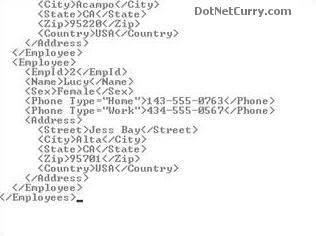
24. Save/Persists Changes to the XML using LINQ to XML
All
the manipulations we have done so far were in the memory and were not
persisted in the XML file. If you have been wondering how to persist
changes to the XML, once it is modified, then here’s how to do so. It’s
quite simple. You just need to call the Save() method. It’s also worth
observing that the structure of the code shown below is similar to the
structure of the end result (XML document). That’s one of the benefits
of LINQ to XML, that it makes life easier for developers by making it so
easy to create and structure XML documents.
C#
XElement xEle = XElement.Load("..\\..\\Employees.xml");
xEle.Add(new XElement("Employee",
new XElement("EmpId", 5),
new XElement("Name", "George"),
new XElement("Sex", "Male"),
new XElement("Phone", "423-555-4224", new XAttribute("Type", "Home")),
new XElement("Phone", "424-555-0545", new XAttribute("Type", "Work")),
new XElement("Address",
new XElement("Street", "Fred Park, East Bay"),
new XElement("City", "Acampo"),
new XElement("State", "CA"),
new XElement("Zip", "95220"),
new XElement("Country", "USA"))));
xEle.Save("..\\..\\Employees.xml");
Console.WriteLine(xEle);
Console.ReadLine();
VB.NET (Converted Code)
Dim xEle As XElement = XElement.Load("..\..\Employees.xml")
xEle.Add(New XElement("Employee", _
New XElement("EmpId", 5), _
New XElement("Name", "George"), _
New XElement("Sex", "Male"), _
New XElement("Phone", "423-555-4224", _
New XAttribute("Type", "Home")), _
New XElement("Phone", "424-555-0545", _
New XAttribute("Type", "Work")), _
New XElement("Address", _
New XElement("Street", "Fred Park, East Bay"), _
New XElement("City", "Acampo"), _
New XElement("State", "CA"), _
New XElement("Zip", "95220"), _
New XElement("Country", "USA"))))
xEle.Save("..\..\Employees.xml")
Console.WriteLine(xEle)
Console.ReadLine()








0 comments:
Post a Comment